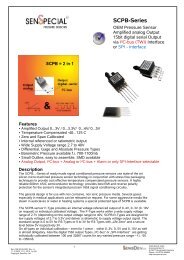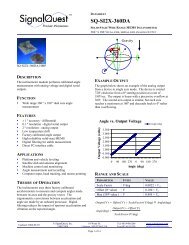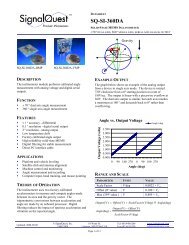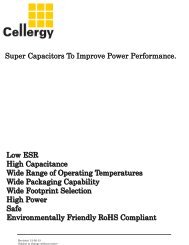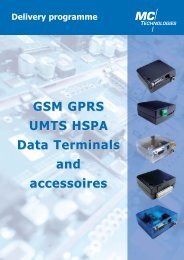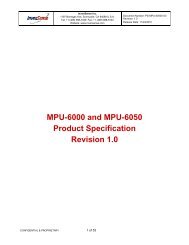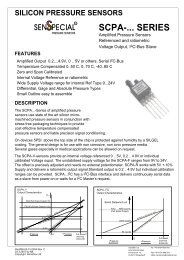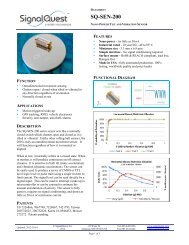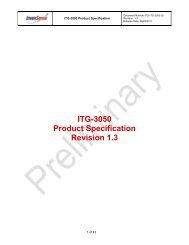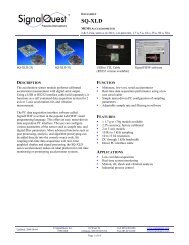Advantages
Advantages
Advantages
- No tags were found...
You also want an ePaper? Increase the reach of your titles
YUMPU automatically turns print PDFs into web optimized ePapers that Google loves.
CELLERGY SUPERCAP TURNS YOUR POWER SOURCE MIGHTYBatteries and Impact of SuperCapacitorsSemion Simma – FAEDate: 02/09/2009
PRIMARY (NON RECHARGEABE)BATTERIES.
Primary (Non-Rechargeable) Batteries.Common Information:Primary batteries are used once, then discarded. They have the advantage of convenience and cost lessper battery, with the down side of costing more over the long term. Primary batteries have a highercapacity and initial voltage than rechargeable batteries. Primary batteries have a sloping discharge curvethan secondary (rechargeable) batteries.<strong>Advantages</strong>:• High energy density• Best alternative for low cost, low drain applications• Wide availability of standard productsDisadvantages:• Not suitable for high drain applications due to short life time and the cost of continuous replacement.• Extremely uneconomical energy source since they produce only about 2% of the power used in theirmanufacture.• They produce much more waste than rechargeable batteries.
Lithium BatteriesCommon Information:•All lithium batteries consist of Lithium anode (negative electrode).•Lithium is the lightest metal and the least dense solid element.Disadvantages:•Like all alkali metals lithium is highly reactive, corroding quickly causing to passivation layer.•Lithium in its elemental state is highly flammable due to sensitivity to high temperatures.•Lithium batteries use a nonaqueous (organic or inorganic) electrolyte , the result is relative high internalimpedance (10-30 Ω).•There are government safety regulations that limit the weight of lithium in commercial shipments,making it very expensive to distribute lithium cells larger than the AA or AAA size.<strong>Advantages</strong>:•Lithium batteries have the highest energy density.•Lithium cells have high nominal voltage 2.7V up to 3.9V.•Lithium batteries are extended to the wide temperature range ( -55°C to +150°C).
Lithium Batteries cont.Lithium Chemistry Differences:• Nominal, minimum and maximum voltage.• Initial, average and maximum discharge current.• Continuous or Pulse operation.• Service life conditions• Shelf life conditions• Operating-temperature range• Permitted Voltage dropFamous Types of Lithium Batteries:• Sulfur dioxide lithium Li-SO2• Lithium thionyl chloride Li-SOCI2• Manganese dioxide lithium Li-MNO2• Poly carbon monofluoride lithium (CF)X-Li• Lithium iodine Lil2
Lithium-Sulfur Dioxide Li-SO2<strong>Advantages</strong>:• Not flammable electrolyte.• Highest pulse capability• At low temperatures and high currents performs better than Li-MnO2.Disadvantages:• Lower energy density than LiMNO2 and LiSOCI2 .• Service life lower than LiMNO2 and LiSOCI2 .• Only 3 manufacturer• High cost• Toxic and corrosive electrolyte• Voltage delay phenomenon (liquid cathode (6))• Requires safety vent, can explode in some conditions.Applications:• Military radio communication• Son buoys and other underwater applications• Emergency location transmitters• Cardiac defibrillatorsSuperCapacitor impact:• Up to now we didn’t find application bases on the LiSO2 battery?
Lithium-Thionyl Chloride Li-SOCI2<strong>Advantages</strong>:• High energy density• Low leakage• High Nominal OCV (open circuit voltage) 3.6V• Nonflammable• Wide operating temperature range.Disadvantages:• High internal impedance relative to other lithium batteries• Passivation layer grows quickly in case of high ambient temperature ( during shelf life).• Low current drawn form battery during the pulse ( despite very high energy) depends on battery type( bobbin or Jelly Role or spiral wound)• High price• Voltage delay phenomenon ( liquid cathode (6))Applications:• Military radio communication• Son buoys and other underwater applications• Emergency location transmitters beacon (ELTs, EPIRBs)• Cardiac defibrillatorsSuperCapacitor impact:• During shelf life SC drawing low current from battery decrease passivation layer reduce voltagedelay problems (2)• During pulse transmissions SC due to low ESR produces pulses prolong battery life time
Lithium-Thionyl Chloride Li-SOCI2 cont.Additional Information:2 Types of Construction Bobbin and Spiral WoundBOBBIN CONSTRUCTION• Designed for applications with long operating cycles & low pulse requirements• Example: AMRSPIRAL WOUND CONSTRUCTION• Designed for applications with long operating cycles & high pulse requirements• Example: RF Transmitters
Lithium-Manganese Dioxide Li-MnO2<strong>Advantages</strong>:• Low cost• No voltage delay phenomenon ( solid cathode(6))Disadvantages:• High self-discharge at high temperatures.• Flammable electrolyte• Low performance under low temperaturesApplications:• Watches• Cameras• Card Readers• Internal Clocks• Memory BackupSuperCapacitor impact:• In case of low ambient temperatures, internal resistance of the battery would increase dramatically up tohundreds Ohms. The ability to deliver high current pulse decrease, SC has low ESR (max 2Ω) abilityto produce high current pulses.
Poly (Carbon Monofluoride)- Lithium (CF)X-Li<strong>Advantages</strong>:• Highest energy density• Very good safety record• Very low self dischargeDisadvantages:• Low Nominal OCV (open circuit voltage) 2.8V• Battery voltage drops drastically at high current discharge (8)• Recovery of dropped voltage takes many hours (8)• High cost (9)• Information on technology very poor (9)Applications:• Military• Cardiac pacemakersSuperCapacitor impact:• Due to low OCV and long time voltage recovery process SC will improve dramatically (CF)X-Li batterybehavior under high current pulses.
Lithium Iodine - Lil2<strong>Advantages</strong>:• Low self discharge• Low costDisadvantages:• Low performance under high temperatures• Low Nominal OCV (open circuit voltage) 2.8V• High internal impendence• Lowest power density• Very poor info on this battery typeApplications:Cardiac pacemakerSuperCapacitor impact:• Due to low OCV and long time voltage recovery process SC will improve dramatically LiI2 batterybehavior under high current pulses.
Primary Lithium Battery Comparison TableLithiumChemistryLithium-SulfurDioxide Li-SO2Lithium-ThionylChloride (Li-SOCI2)Lithium-ManganeseDioxide (LiMnO2)Poly (CarbonMonofluoride)-LithiumLithiumIodine (Lil2)Energy DensityLowBobbin (High), Spiralwound (Low)ModerateVery HighLowCell Voltage3V3.67V3V2.8V2.8VPulse amplitudeHighBobbin (Low), Spiralwound (High)ModerateLowModeratePassivationHighHighModerateModerateHighPerformance atR.T.ModerateHighModerateModerateModeratePerformance in lowtemperaturesModerateLowPoorLowLowOperating lifeModerateHighModerateModerateModerateSelf-discharge rate3% a year (RT)1%-3% a year (RT)3% a year (RT)1% (RT)1%(RT)Operatingtemperature-60°C to +70°C-55°C to +100°C-20°C to +70°C-20°C to +60°C??????
OTHER PRIMERY BATTERIES.
Lechlanche Dry CellsCommon information:Primary cell with a nominal open circuit voltage of 1.5 Volts produced in very high volumes.Chemistry based on a zinc anode and a cathode/depolarizers of manganese dioxide which absorbs theliberated hydrogen bubbles which would otherwise insulate the electrode from the electrolyte. It uses acarbon rod as the cathode current collector with an electrolyte of ammonium chloride. Its variants have beenin use for over a century.Variants include:• Zinc carbon (Carbon cathode)• Zinc chloride (Ammonium chloride electrolyte replaced by zinc chloride)• Alkaline manganese ( Ammonium chloride electrode replaced by potassium hydroxide)<strong>Advantages</strong>:• Lowest cost of primary batteries• Available in a wide range of sizes including AAA, AA, C, D and 9Volt sizes.• Interchangeable with alkaline batteriesDisadvantages:• High leakage• Lower energy density than the alkaline batteries• Poor low temperature performance• Losing market share to alkaline cells and newer technologies
Lechlanche Dry Cells cont..Applications:Low cost applicationsToysRemote controlFlashlightsClocksSuperCapacitor impact:• Due to low OCV it can’t to supply 2.2-2.8 V for devices including microprocessor. It requires to put DC-DC converter in order to increase voltage of battery from 1.5V to 2.8V, it requires higher pulse currentfrom battery. This type of battery doesn’t have ability to support high current pulses, due to low capacityand high leakage. In this case SC is required to supply high current pulse in order to allowmicroprocessor to work properly and to increase battery lifetime.• Due to poor performance in low temperatures environment of Lechlanche Dry Cells, SC is required tosupply high current pulses. The algorithm is simple, battery will charge SC in low current, and when pulsewould be required SC should deliver it due to excellent performance in low ambient temperatures.
Alkaline (Alkaline Manganese Dioxide)Common information:Many battery chemistries use alkaline electrolytes but "Alkaline Batteries" usually refers to the“Alkaline Manganese Dioxide” primary cells. 1.5 Volt primary cell. Most popular premium general purposebattery.The Alkaline Manganese Dioxide battery is a variant on the Leclanche cell.As with the Leclanche cell the electrodes are zinc and manganese dioxide but the electrolyte is potassiumhydroxide (KOH).Potassium hydroxide is also used as the electrolyte in most of the Nickel based rechargeable cells.<strong>Advantages</strong>:• Similar to zinc carbon Leclanche cells but doubles Leclanche cell energy density• 4 times the capacity of a equivalent size rechargeable Nickel Cadmium or Nickel Metal Hydride cells.• 4 to 9 times longer life than the equivalent Leclanche cell.• Constant capacity over a wide range of current drains.• Better low temperature performance than zinc carbon• Available in a wide range of sizes• Made from non toxic chemicalsDisadvantages:• High leakage• Higher cost than the basic competing zinc carbon Leclanche cells• Low performance under sub-zero temperatures.
Alkaline (Alkaline Manganese Dioxide) cont..Applications:• Low cost applications• Toys• Remote control• Flashlights• ClocksSuperCapacitor impact:• Due to low OCV it can’t to supply 2.2-2.8 V for devices including microprocessor. It requires to put DC-DC converter in order to increase voltage of battery from 1.5V to 2.8V, it requires higher pulse currentfrom battery. This type of battery doesn’t have ability to support high current pulses, due to low capacityand high leakage. In this case SC is required to supply high current pulse in order to allowmicroprocessor to work properly and to increase battery lifetime.• Due to poor performance in low temperatures environment of Lechlanche Dry Cells, SC is required tosupply high current pulses. The algorithm is simple, battery will charge SC in low current, and when pulsewould be required SC should deliver it due to excellent performance in low ambient temperatures.
Zinc/Silver Oxide or Silver Zinc BatteriesCommon information:Common low capacity primary button cell versions are typically called Silver Oxide batteries. They have anopen circuit voltage of 1.6 Volts. Two types of Silver Oxide batteries are available, one type with asodium hydroxide (NaOH) electrolyte and the other with a potassium hydroxide (KOH) electrolyte.Because of the high cost of sliver they are available in either very small sizes as button cells where theamount of silver used is small and not a significant contributor to the overall product costs or they areavailable in very large sizes for critical applications where the superior performance characteristics ofthe silver oxide chemistry outweigh any cost considerations.<strong>Advantages</strong>:• High energy density• Cell OCV = 1.6V , higher than alkaline cell• Low self discharge long shelf life (better than zinc air)• Better low temperature performance than zinc air• Flat discharge characteristics - flatter than alkaline battery.Disadvantages:• High cost (Silver)• Lower energy density than zinc air.• Poor low temperature performance.• Suffers from dissolving of the Zinc and the formation of Zinc dendrites which pierce the separator.• Very expensive for high power applications
Zinc/Silver Oxide Battery cont..Applications:• Contribution to miniature power sources• Hearing aids• Instruments• Photographic applications• Electronic watches• Big size Silver Zinc batteries are used in submarines and missilesSuperCapacitor impact:• Very expensive for high power applications – It is exactly case when SC is extremely required.The customer invited to implement application with little zinc/oxide battery +SC , this combination willhave same impact as big zinc/oxide battery, but with much lower cost.• Due to poor performance in low temperatures environment of zinc/silver oxide battery, SC is required tosupply high current pulses. The algorithm is simple, battery will charge SC in low current, and when pulsewould be required SC should deliver it due to excellent performance in low ambient temperatures.
Zinc Air BatteriesCommon information:Cells using zinc-air technology are energized only when atmospheric oxygen is absorbed into the electrolytethrough a gas-permeable, liquid-tight membrane. With the removal of a sealing tab, oxygen from the airis introduced into the cell. A zinc-air battery usually reaches full operating voltage within 5 seconds ofbeing unsealed. The cell voltage for the chemistry is theoretically capable 1.65 Volts however almost alldesigns are optimized for less than 1.4 or 1.3 Volts in order to achieve longer lifetimes.<strong>Advantages</strong>:• High energy density• Inexpensive materials• The zinc-air system, when sealed, has excellent shelf life• High energy per unit of weight,higher than almost any other primary type batteryDisadvantages:• Low power ( very high internal resistance)• Sensitive to extreme temperature and humid conditions• Carbon dioxide from the air forms carbonate which reduces conductivity• High self discharge• After activation, chemicals tend to dry out and the batteries have to be used quickly
Zinc Air Batteries cont..Applications:• Watches• Hearing aids• Larger types are employed as prismatic or cylindrical cells for telecoms and railway remote signaling,safety lamps at road and rail construction sites or as power sources for electric fences.SuperCapacitor impact:• Low power ( very high internal resistance)– It is exactly case when SC is extremely required.The customer invited to implement application with little zinc air battery +SC , this combination will havesucceed to produce high current pulses due to SC’s low ESR.
Other Primary Battery Comparison TableBattery ChemistryLechlancheDry CellsAlkaline ManganeseDioxideZinc/Silver OxideZinc AirEnergy DensityLowHighLowHighCell Voltage1.5V1.5V1.6V1.4VPulse amplitudeLowHighHighLowPassivationPoorPoorPoorPoorPerformance atR.T.ModerateModerateModerateModeratePerformance in lowtemperaturesLowLowLowLowOperating lifeLowModerateModerateModerateSelf-discharge rateHighHighLowHighOperatingtemperature-10°C to +55°C-20°C to +55°C-28°C to +55°C-10°C to +55°CComparison does not include lithium batteries!



